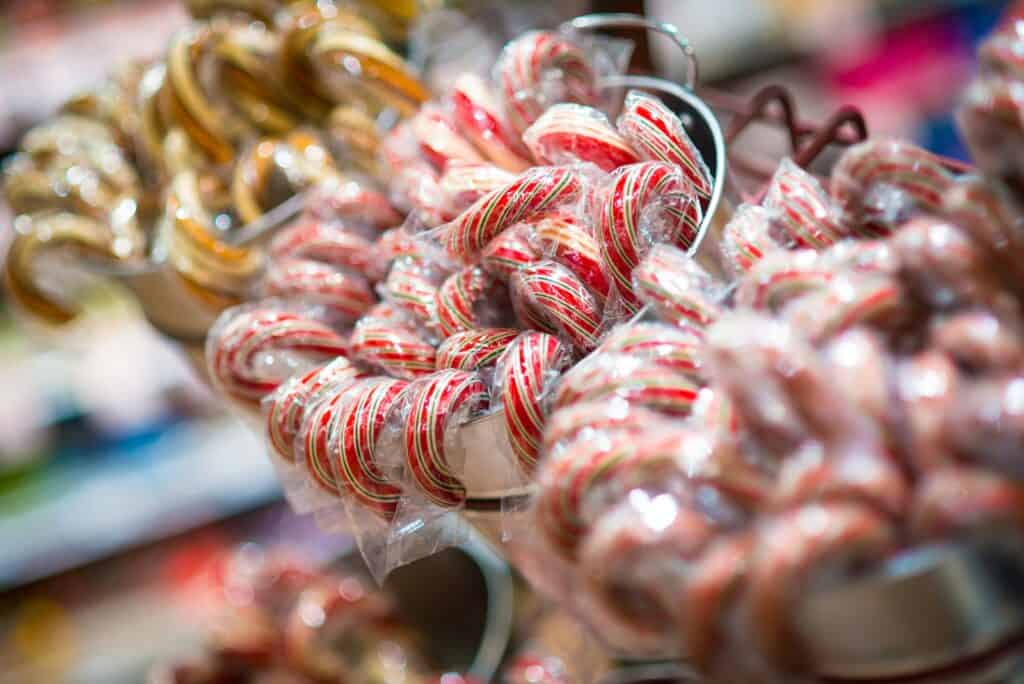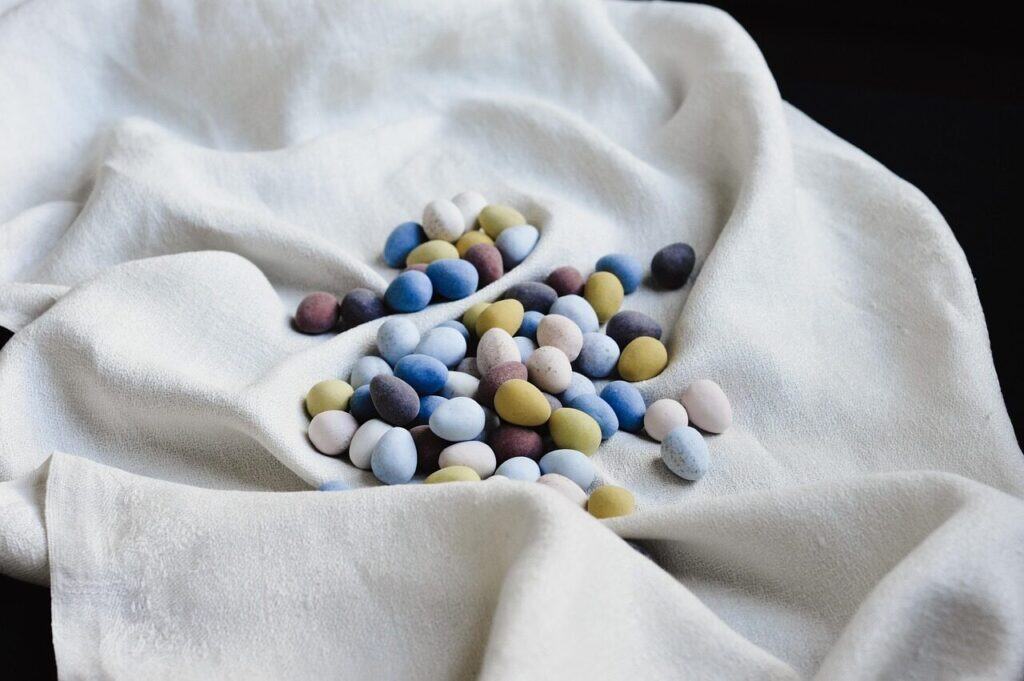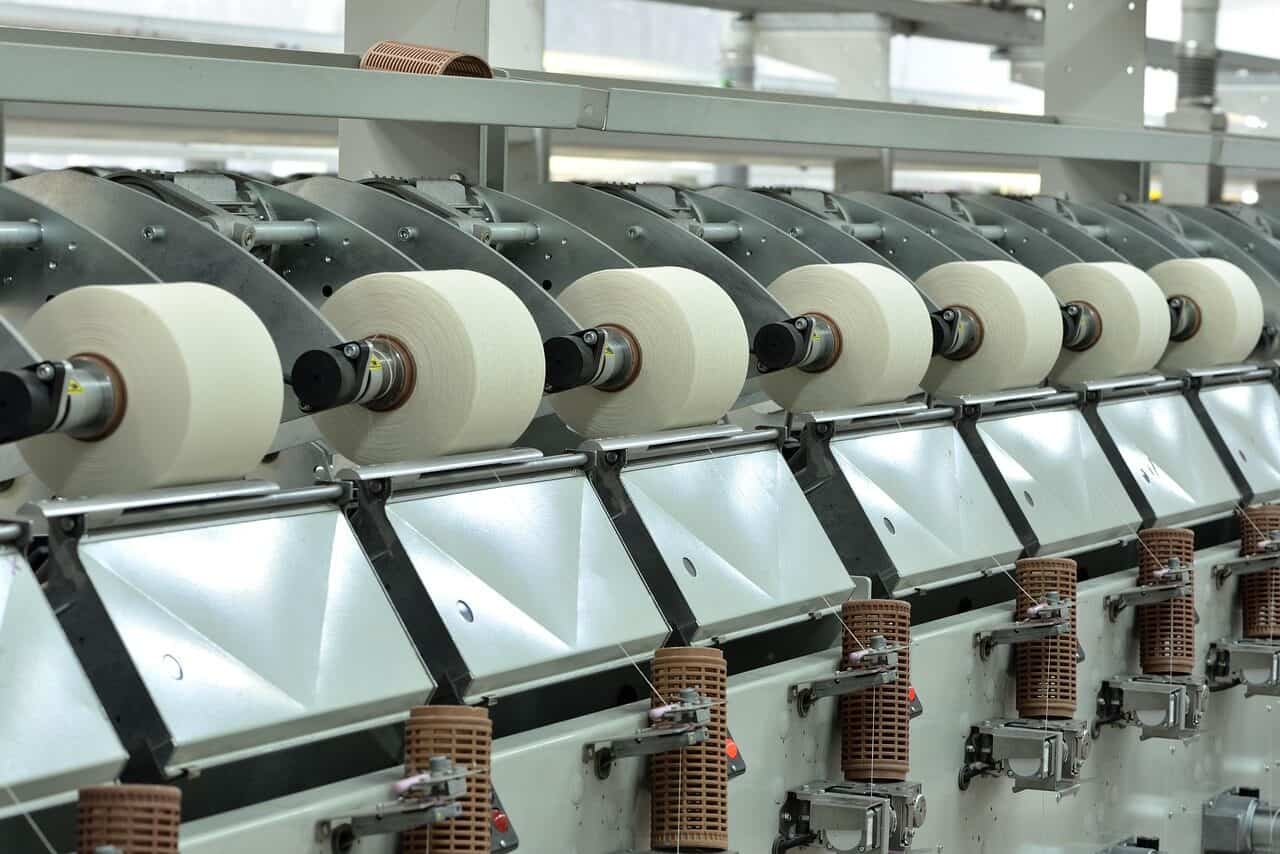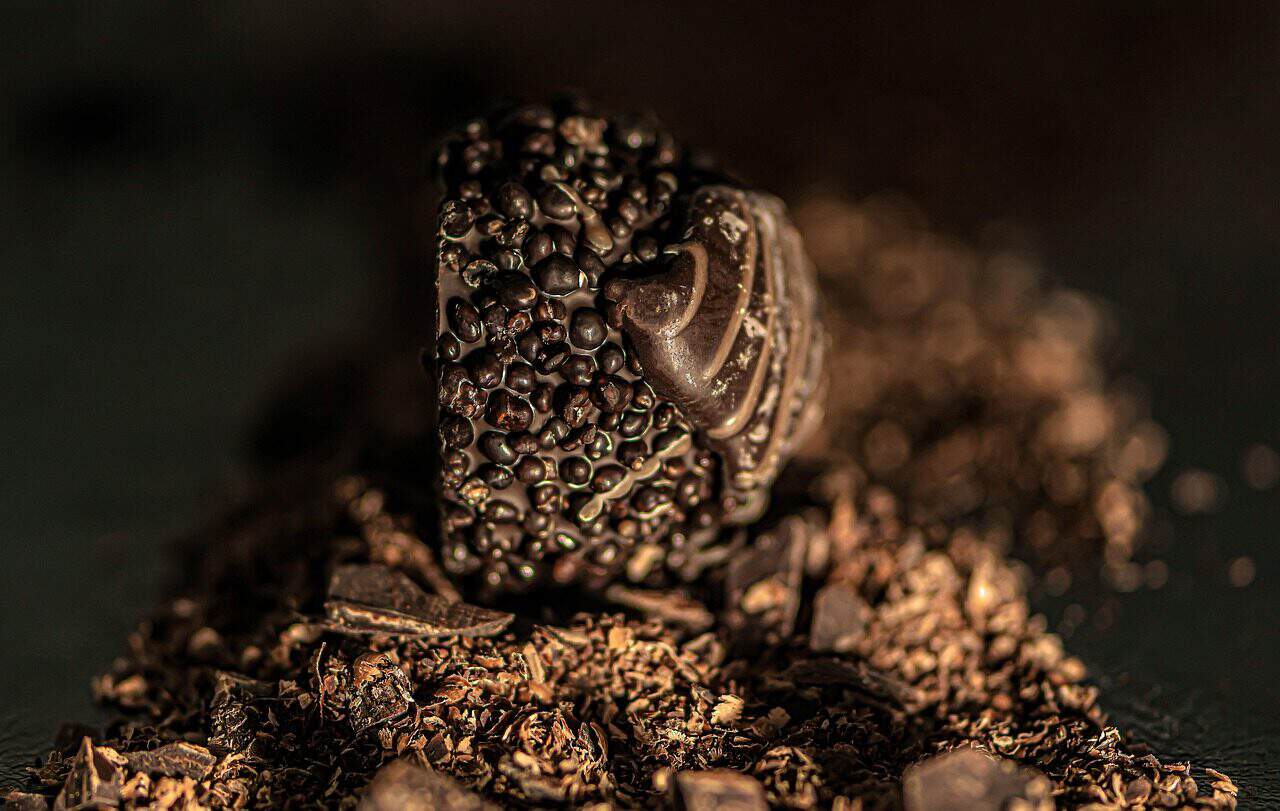La science de la douceur : Une analyse technique des sucres d'orge sans sucre
Regardez : La fabrication des sucres d'orge
Voir le fascinant processus industriel de fabrication de la canne à sucre
Déconstruction du classique
Pour comprendre pourquoi les sucres d'orge sans sucre sont si intelligents, il faut d'abord comprendre les sucres d'orge ordinaires. Le sucre de table ne se contente pas de donner un goût sucré. C'est en fait l'épine dorsale de tout le bonbon.

Les cristaux de sucre constituent l'ossature structurelle des bonbons traditionnels.
Propriétés multifonctionnelles du saccharose
Dans la fabrication des bonbons, le sucre jongle avec plusieurs tâches à la fois. Si vous l'enlevez, vous devez remplacer non seulement le goût, mais aussi tout ce qu'il fait.
Le travail le plus important est la structure. Les bonbons durs ne sont en fait que des “verres” de sucre. Les fabricants de bonbons dissolvent des tonnes de sucre dans de l'eau pour obtenir un mélange très concentré.
Ce mélange est chauffé à très haute température - environ 300°F ou 150°C. Cela permet d'éliminer la plus grande partie de l'eau. Cela permet d'éliminer la plus grande partie de l'eau. Puis ils le refroidissent rapidement. Le refroidissement rapide empêche les molécules de sucre de s'aligner en rangs bien ordonnés.
Au lieu de cela, ils gèlent dans un état désordonné, appelé solide amorphe. Ce “état de transition vitreuse”C'est la "pâte à sucre" qui donne aux sucres d'orge leur aspect dur et cassant et qui leur confère ce craquement si satisfaisant.
Le sucre a également d'autres effets importants :
- Il donne au bonbon sa taille et son volume.
- Il retient les arômes comme l'huile de menthe poivrée, en les emprisonnant dans sa structure vitreuse.
- Il affecte la sensation du bonbon et la façon dont il fond dans la bouche.
Architectes du “sans sucre”
Le remplacement du sucre nécessite une approche intelligente et multiple. La solution fait appel à deux grands types de substituts. Les agents de charge apportent la structure. Les édulcorants à haute intensité apportent le goût.
Les agents de charge
Les alcools de sucre, ou polyols, sont les principaux substituts structurels du sucre. Leurs molécules ressemblent au sucre mais possèdent un groupe d'alcool. Cela modifie la façon dont notre corps les traite.
Ils donnent le volume nécessaire et peuvent former l'état vitreux requis pour les bonbons durs.
L'isomalt est le polyol le plus important dans les bonbons durs sans sucre. C'est le préféré de l'industrie en raison de ses excellentes propriétés chimiques. Il possède une température de transition vitreuse élevée et n'absorbe pas facilement l'humidité de l'air. Cela signifie que le bonbon final reste stable et ne colle pas.
L'érythritol est un autre choix populaire. Il ne contient pratiquement pas de calories - environ 0,24 kcal/g contre 4 kcal/g pour le sucre. Le système digestif de la plupart des gens le supporte bien. Sa caractéristique principale est la sensation de fraîcheur qu'il crée dans la bouche.
D'autres polyols comme le xylitol et le maltitol sont également utilisés. Ils ont un goût assez sucré mais peuvent provoquer des maux d'estomac si vous en consommez trop.
Les organismes de réglementation tels que la La Food and Drug Administration des États-Unis classe ces ingrédients dans la catégorie GRAS. (Generally Recognized as Safe).
Les acteurs du pouvoir
Les alcools de sucre ne sont généralement pas aussi sucrés que le sucre ordinaire. L'isomalt, par exemple, n'est que 45-65% aussi sucré. Pour compenser, les fabricants ajoutent de minuscules quantités d'édulcorants de haute intensité.
Ces substances sont des centaines ou des milliers de fois plus sucrées que le sucre. Il n'en faut qu'un tout petit peu.
Le sucralose est un édulcorant artificiel courant qui reste stable à la chaleur élevée de la fabrication des bonbons.
La stévia provient de la Stevia rebaudiana de la plante. Il s'agit d'une autre option sans calories. Les gens la choisissent souvent parce qu'elle est “naturelle”, bien qu'elle puisse parfois avoir un goût légèrement amer ou ressembler à de la réglisse.
L'acésulfame potassique (Ace-K) est souvent mélangé à d'autres édulcorants. Mélanger les édulcorants est une astuce intelligente pour obtenir un goût plus proche de celui du sucre et masquer tout arrière-goût bizarre provenant d'un seul ingrédient.
Résumé technique comparatif
| Édulcorant | Type | Douceur ou sucre | Valeur calorique (kcal/g) | Indice glycémique | Propriété principale de la confiserie | Effets secondaires fréquents |
|---|---|---|---|---|---|---|
| Isomalt | Polyol | 0.45-0.65x | ~2.0 | 2-9 | Excellente stabilité, faible hygroscopicité | Troubles digestifs en cas d'excès |
| Erythritol | Polyol | 0.6-0.8x | ~0.24 | ~1 | Effet de refroidissement important, haute tolérance digestive | Effet laxatif léger à fortes doses |
| Sucralose | HIS | ~600x | 0 | 0 | Grande stabilité à la chaleur, profil gustatif net | Certains signalent un arrière-goût persistant |
| Stévia (Reb-A) | HIS | 200-400x | 0 | 0 | Dérivé de plantes, zéro calorie | Peut avoir un arrière-goût amer ou de réglisse. |
L'ingénierie structurelle
Le plus grand défi consiste à créer la structure vitreuse et cassante d'un sucre d'orge sans sucre. Il s'agit essentiellement de science des matériaux, c'est-à-dire de remplacer un squelette chimique par un autre.
Reproduire la “transition de verre”
L'objectif principal est de créer un solide stable et amorphe tout en empêchant la cristallisation. Un sucre d'orge granuleux est un sucre d'orge raté.
Le sucre peut former ce verre, mais il veut absolument revenir à son état de cristal. Il attire également l'eau, qui peut ramollir les bonbons et déclencher la cristallisation au fil du temps.
C'est là que l'Isomalt se distingue. Isomalt n'est pas un composé unique, mais un mélange de deux alcools disaccharidiques différents. Cette variété moléculaire “contrarie” naturellement la formation de cristaux. Les molécules ne s'emboîtent pas assez bien pour se cristalliser facilement.
De plus, l'Isomalt a une température de transition vitreuse (Tg) que le sucre. Cela signifie qu'il passe d'un état caoutchouteux à un état vitreux à une température plus élevée. Il en résulte des bonbons plus durs et plus stables que l'humidité ne peut pas altérer aussi facilement. Cela facilite à la fois la fabrication et la durée de conservation.
Apprendre : Travailler avec l'isomalt pour l'art du sucre
Techniques professionnelles pour travailler avec l'isomalt dans fabrication de bonbons
L'art de la traction
Les rayures blanches et opaques emblématiques des sucres d'orge ne sont pas seulement des couleurs. Elles résultent d'un processus physique appelé "traction".
Après la cuisson de la masse de bonbons en fusion, une partie de celle-ci est séparée et étirée. Cet étirement, ce pliage et cette torsion incorporent des millions de petites bulles d'air dans le bonbon.
Les propriétés d'étirement de la masse fondue à base d'Isomalt sont remarquablement similaires à celles de la masse à base de sucre. Il est possible de l'étirer et de la plier à plusieurs reprises sans qu'elle ne se casse.
Le processus d'arrachage traditionnel permet de créer les bandes blanches caractéristiques.
Ces bulles d'air emprisonnées diffusent la lumière. Cela modifie l'apparence du bonbon, qui passe d'un blanc transparent à un blanc opaque. Il en modifie également la texture, le rendant plus léger et lui donnant un goût légèrement différent de celui des sections rouges transparentes.
L'expérience sensorielle et physiologique
La science de ces ingrédients influe directement sur le goût des sucres d'orge sans sucre. Le choix des substituts détermine le goût, la texture et la façon dont votre corps réagit.
Les sucres d'orge sans sucre procurent le même plaisir mais avec des effets métaboliques différents.
Le profil de saveur
L'expérience gustative va au-delà du simple goût sucré. Chaque substitut apporte son propre caractère au produit final.
L'un des effets les plus perceptibles est la sensation de “refroidissement”. C'est la signature de l'érythritol. Lorsqu'il se dissout dans la salive sur votre langue, il subit une réaction endothermique. Cela signifie qu'il absorbe la chaleur environnante. Il en résulte une sensation de refroidissement perceptible et agréable qui s'associe parfaitement à l'arôme de menthe poivrée.
L'arrière-goût est également important. Certains édulcorants à haute intensité, en particulier la stévia ou l'Ace-K, peuvent laisser une légère note métallique ou légèrement amère chez les personnes sensibles. Les fabricants de bonbons s'efforcent de minimiser ce phénomène grâce à des mélanges précis, mais la différence avec la finition nette du sucre peut être subtile.
Le moment de la sucrosité peut également varier. Le sucre a un effet sucré rapide et immédiat. Certains substituts peuvent avoir un goût sucré légèrement plus lent, qui reste plus longtemps sur la langue.
La réponse de l'organisme
C'est là que réside le principal avantage pour de nombreuses personnes : l'impact sur la glycémie et la digestion.
Le corps humain ne dispose pas des enzymes nécessaires pour décomposer complètement les alcools de sucre et les édulcorants de haute intensité. Ils n'ont donc qu'un effet minime, voire nul, sur la glycémie. Ceci est très important pour les personnes souffrant de diabète.
Les bonbons sans sucre aident à maintenir une glycémie stable
L'index glycémique (IG) mesure la vitesse à laquelle les aliments augmentent le taux de sucre dans le sang. Il est très révélateur. L'IG du sucre est d'environ 65. L'érythritol a un IG d'environ 1. Celle de l'isomalt se situe entre 2 et 9. Les sucres d'orge sans sucre sont donc une véritable option pour les personnes qui gèrent leur glycémie.
L'aspect digestif est également important. Comme les polyols ne sont pas entièrement absorbés dans l'intestin grêle, ils sont acheminés vers le gros intestin. Là, les bactéries intestinales peuvent les fermenter.
Ce processus peut avoir un effet osmotique, en attirant l'eau dans le côlon. Chez certaines personnes, en particulier lorsqu'elles mangent trop, cela peut provoquer des gaz, des ballonnements ou un effet laxatif.
La tolérance varie beaucoup d'une personne à l'autre. L'érythritol est généralement considéré comme l'un des polyols les mieux tolérés. Une grande partie est absorbée puis excrétée sous forme inchangée dans l'urine, sans jamais atteindre le gros intestin. La clé est la modération.
La synthèse sucrée
Le passage des sucres d'orge traditionnels aux sucres d'orge sans sucre témoigne de la créativité scientifique dans ce qu'elle a de meilleur. Il révèle comment nous pouvons réduire un aliment à ses fonctions essentielles et le reconstruire avec de nouveaux matériaux.
Les sucres d'orge modernes sans sucre sont disponibles dans de nombreuses versions. arômes et couleurs
Nous avons vu que le double rôle du sucre en tant qu'édulcorant et épine dorsale structurelle doit être pris en compte. Nous avons analysé la solution en deux parties : les polyols comme Isomalt fournissent la structure vitreuse et stable, et les édulcorants à haute intensité apportent le goût puissant.
La compréhension de cette chimie transforme un simple bonbon en une merveille d'ingénierie. Elle rend les fêtes de fin d'année plus inclusives. La joie d'une friandise classique peut être partagée par ceux qui doivent, ou choisissent, de gérer leur consommation de sucre. La science rend les fêtes plus douces et plus accessibles à tous.
Les sucres d'orge sans sucre rendent les traditions de Noël accessibles à tous.
Questions fréquemment posées
Les sucres d'orge sans sucre sont-ils sans danger pour les diabétiques ?
Oui, sans sucre sucre d'orge fabriqué avec des alcools de sucre comme l'isomalt et l'érythritol ont un impact minime sur la glycémie, ce qui les rend appropriés pour les personnes atteintes de diabète lorsqu'ils sont consommés avec modération.
Qu'est-ce qui donne aux sucres d'orge sans sucre leur structure sans sucre ?
Les alcools de sucre, en particulier l'isomalt, forment une structure vitreuse similaire au sucre lorsqu'ils sont chauffés et refroidis, ce qui leur confère la dureté et le claquement caractéristiques des sucres d'orge.
Les sucres d'orge sans sucre ont-ils un goût différent des sucres d'orge ordinaires ?
Ils peuvent présenter des différences subtiles, telles qu'une sensation de refroidissement due à l'érythritol ou un léger arrière-goût dû à certains édulcorants, mais les formulations modernes reproduisent fidèlement la saveur traditionnelle du sucre d'orge.
A propos de l'auteur
Cet article explore l'intersection fascinante de la science alimentaire et de la fabrication de confiseries, en mettant des concepts chimiques complexes à la portée de tous.










